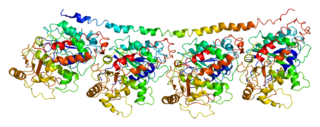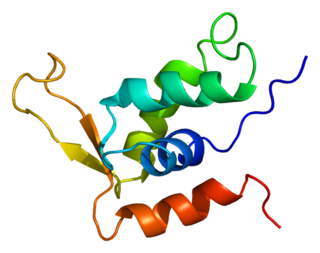
Tubulin alpha-4A chain is a protein that in humans is encoded by the TUBA4A gene.

Olfactory receptor 51B2 is a protein that in humans is encoded by the OR51B2 gene.

Olfactory receptor 8J3 is a protein that in humans is encoded by the OR8J3 gene.

Olfactory receptor 51A7 is a protein that in humans is encoded by the OR51A7 gene.

Olfactory receptor 10Z1 is a protein that in humans is encoded by the OR10Z1 gene.

Olfactory receptor 2Z1 is a protein that in humans is encoded by the OR2Z1 gene.

Olfactory receptor 5J2 is a protein that in humans is encoded by the OR5J2 gene.

Olfactory receptor 1B1 is a protein that in humans is encoded by the OR1B1 gene.

Olfactory receptor 1J1 is a protein that in humans is encoded by the OR1J1 gene.

Olfactory receptor 13J1 is a protein that in humans is encoded by the OR13J1 gene.

Olfactory receptor 14J1 is a protein that in humans is encoded by the OR14J1 gene.

Microtubule-associated protein RP/EB family member 3 is a protein that in humans is encoded by the MAPRE3 gene.

Forkhead box protein K2 is a protein that in humans is encoded by the FOXK2 gene.

Kinesin-like protein KIFC1 is a protein that in humans is encoded by the KIFC1 gene.

Microtubule-associated protein 1S is a protein that in humans is encoded by the MAP1S gene.

Transcription factor RFX3 is a protein that in humans is encoded by the RFX3 gene.

Pleckstrin homology-like domain family B member 2 is a protein that in humans is encoded by the PHLDB2 gene.

Tektin-1 is a protein that in humans is encoded by the TEKT1 gene.

Calmodulin regulated spectrin associated protein family member 2 (CAMSAP2) is a protein that in humans is encoded by the CAMSAP2 gene. It acts as a microtubule minus-end anchor, and binds microtubules through its CKK domain.

Calmodulin-regulated spectrin-associated protein family member 3 (CAMSAP3) is a human protein encoded by the gene CAMSAP3. The protein is commonly referred to as Nezha.











